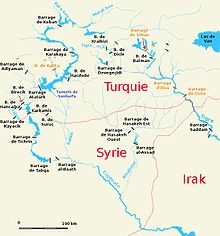| Balikh Arabic: البليخ | |
|---|---|
 Map (in French) of the Syro–Turkish part of the Tigris–Euphrates river system, with the Balikh shown in the center left | |
| Location | |
| Country | Syria |
| Basin area | Turkey |
| Cities | Tell Abyad, Raqqa |
| Physical characteristics | |
| Source | Ain al-Arous |
| • coordinates | 36°40′13″N 38°56′24″E / 36.67028°N 38.94000°E |
| • elevation | 350 m (1,150 ft)approx. |
| Mouth | Euphrates |
• coordinates | 35°55′21″N 39°4′40″E / 35.92250°N 39.07778°E |
• elevation | 250 m (820 ft)approx. |
| Length | 100 km (62 mi)approx. |
| Basin size | 14,400 km2 (5,600 sq mi) |
| Discharge | |
| • location | Ain al-Arous[1] |
| • average | 6 m3/s (210 cu ft/s) |
| • minimum | 5 m3/s (180 cu ft/s) |
| • maximum | 12 m3/s (420 cu ft/s) |
| Basin features | |
| Tributaries | |
| • left | Jullab, Wadi al-Kheder |
| • right | Wadi Qaramogh |
| [2][3][4] | |
The Balikh River (Arabic: نهر البليخ) is a perennial river that originates in the spring of Ain al-Arous near Tell Abyad in the Eastern Mediterranean conifer-sclerophyllous-broadleaf forests ecoregion. It flows due south and joins the Euphrates at the modern city of Raqqa. The Balikh is the second largest tributary to the Euphrates in Syria, after the Khabur River. It is an important source of water and large sections have recently been subjected to canalization.
- ^ The discharge figures predate the introduction of large-scale irrigation works in the valley and may have changed significantly since then.
- ^ Wirth, E. (1971). Syrien. Eine geographische Landeskunde. Darmstadt: Wissenschaftliche Buchgesellschaft. p. 110. ISBN 3-534-02864-3.
- ^ Wilkinson, T.J. (1998). "Water and human settlement in the Balikh Valley, Syria: investigations from 1992-1995". Journal of Field Archaeology. 25 (1). Boston University: 63–87. doi:10.2307/530458. JSTOR 530458.
- ^ "Volume I: Overview of present conditions and current use of the water in the marshlands area/Book 1: Water resources" (PDF). New Eden Master Plan for integrated water resources management in the marshlands areas. New Eden Group. 2006. Archived from the original (PDF) on 27 July 2011. Retrieved 11 October 2009.